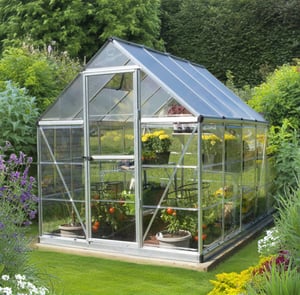
£5 OFF Everything!
Use code SPRING5 in the basket min order £199 (Everything)
Allotment Greenhouse
When choosing a greenhouse for an allotment, there are a few extra things to consider that might not affect a greenhouse in your garden. Hopefully this brief guide will help you avoid some pitfalls.
Where to site the Greenhouse on the Allotment
Just as with a garden, you want to place your greenhouse on sheltered level ground, free from shading and avoiding frost pockets. Allotments are sadly often subject to vandalism and nothing seems to delight bored schoolboys more than the sound of breaking glass. Try to position the greenhouse as far from boundaries and gates as possible.
Some sites have rules as to where constructions can be placed and about the size of them. It's well worth asking your site manager what's acceptable before you start.
Top 12 Best Allotment Greenhouses
Base for the Greenhouse
Many allotments, rightly in my opinion, do not allow poured concrete foundations and brick built bases or walls. After all, you won't be there forever and the next tenant might not want your greenhouse base built to bomb-shelter standards!
For a small greenhouse, levelling the soil and blinding with sand before laying slabs down over weed suppressant membrane will often be an acceptable and quick solution. Once you leave the plot, the slabs and membrane can be lifted if not needed and the ground dug over. Another option for a small greenhouse, say 6x8, is to use pressure-treated fence posts as sleepers laid onto levelled ground as a base. If you can, make a shallow trench under the sleepers and fill with gravel to provide some drainage in rainy weather so the sleepers are not sitting in water and rotting.
With a larger greenhouse fence posts may not be up to the job and proper sleepers, usually about 250mm x 125mm would be required. DO make sure treated timer is used or treat yourself with a good quality product like Cuprinol.
Make sure your Greenhouse Base is Square and Level.
It's fairly straightforward to make sure the base is level with a spirit level, try and use a four foot level rather than a small one for accuracy. Keeping the base square is trickier than you might think. Lay the beams out in a rectangle and then measure the diagonals from corner to corner. These should be equal.
To ensure a right angle joint is a right angle, use the carpenter's 3:4:5 method as discovered by Pythagoras. Measure three feet on one edge, four on the other and the distance between those points should be five feet when things are square.
Type of Greenhouse for the Allotment
There's no doubt in my mind that an aluminium (metal) freestanding greenhouse is by far the best choice for an allotment. Wooden houses do look better but are more expensive, take longer to build and are far more difficult to move should you leave the plot.
Glazing for the Allotment Greenhouse
You've a choice of glazing for a greenhouse. The cheapest is standard horticultural glass. This is fine in many situations but does break fairly easily (remember those bored schoolboys) and if you take young children down to the plot can present a significant risk if they run into the house.
Toughened glass is stronger and if it breaks, breaks safe into thousands of pieces. Toughened glass will certainly be better in windy conditions and will resist impacts better but do remember it's tough but not bulletproof. A thrown stone may well cause a pane to go and toughened glass is a lot more expensive than horticultural glass or polycarbonate.
Polycarbonate is an ideal glazing choice where vandalism is a problem. It's more resistant and also very economical as it tends to retain heat very well indeed. In fact poly glazing is double glazed as it has a cavity inside allowing it to absorb and hold onto heat from the sun or equally your greenhouse heater.
Must Have Extras for the Allotment Greenhouse
The biggest problem with any greenhouse is over-heating. A hot, sunny day can literally cook your plants, especially seedlings. And in Britain, who knows what the weather can bring from one day to the next?
Automatic vent openers will open the vents when it gets warm and shut them again when it gets cool, protecting your plants from extreme heat and chill whilst you're not there. They're relatively inexpensive and last for years.
A louvre vent with an automatic opener is particularly useful in very warm weather, helping to create a cooling through draft even when the door is shut. Rainwater collecting gutters draining into a butt are a boon when everyone is fighting to get to the water taps in the summer. Brownie points for being green as well!
In a larger greenhouse a slimline water butt inside the house is useful, holding the water at the same temperature as the air and avoiding the shock of cold water on young seedlings. In a smaller house you can just have a couple of large watering cans holding water for the seedlings.
Hopefully you'll have many years of trouble free growing in your allotment greenhouse and avoid some of the pitfalls. My final tip, whatever size of greenhouse you have, in the height of the season you'll wish you had a little more space for just one more tomato variety, or cucumber plant.






















